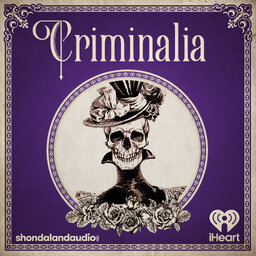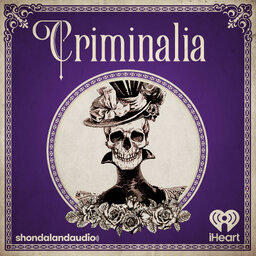


Criminalia
Playlist by CriminaliaHumans have always committed crimes. What can we learn from the criminals and crimes of the past, and have humans gotten better or worse over time?Follow the podcast:
279 clip(s) in playlist

Farewell, From Criminalia, and Thanks for All the Crime
Thank you for joining us for the final episode of our season of stray heists AND the finale of Criminalia. This is goodbye, but it's also thank you – thank you for supporting us as we walked in and out of historical crime scenes, nefarious cocktails, and we are grateful you took this adventure with…
42:30
'America': The Stolen Golden Toilet
The plan was to keep the 18-karat-gold toilet called 'America' on display indefinitely at the Guggenheim Museum in New York City. But it did go out on loan, once, to Blenheim Palace, a UNESCO World Heritage Site and the birthplace of Winston Churchill, in 2019, as part of an exhibition of Maurizio …
25:08
Mayhem, Madness, and Marshmallow the Bunny: When the World Lost Its Mind Over Beanie Babies
When Beanie Babies hit the scene in 1993, the original line of stuffed toys featured nine characters -- but that number would grow to hundreds. The brainchild of Ty Warner, and made by his company, Ty Inc., they were one of the hottest toys of the 1990s -- but they also inspired an underground econ…
35:19
Piano 'Movers' Play a Felonious Tune
Just after lunch on July 14, 2013, a white van drove away from Toronto General Hospital. Its cargo? A stolen Boston Steinway baby grand piano, taken from the hospital's Peter Munk Cardiac Centre. Of the bold heist, Todd Milne, director of security operations for the hospital, told the media, quote,…
21:35
California Nut Crimes: Nuts Cases Can Be Difficult to Crack
Tree nuts have become are a hot commodity on the black market, and thieves have been making off with shipments of California-grown nuts to cash in. Of the phenomenon, Mike Boudreaux, the sheriff of Tulare County in California’s Central Valley, stated, “It’s not your guy on the corner in the long ja…
25:51
Opening the Lid on Manhole Cover Capers
In the spring of 2008, 12-year-old Shamira Fingers was walking down a street near her home in South Philadelphia when she suddenly and surprisingly fell into an open sewer hole -- the manhole cover, missing. Once a rare crime, disappearing manhole covers has become an expensive and dangerous proble…
26:42
Big Syrup': The Great Canadian Maple Syrup Heist
"You can't prove what tree the syrup came from," stated one of the accomplices in The Great Canadian Maple Syrup Heist during his trial. Over the span of several months, thieves staged a multi-million dollar heist from Québec's Global Strategic Maple Syrup Reserve, making off with about 3,000 tonne…
29:15
Welcome to the Season Finale of Criminalia: THE GENTLEMEN ROBBER
Stand and deliver! Welcome to the final episode of our season about highway robbery and the outlaws who preyed upon road travelers. There were plenty of flinklock pistols, plenty of executions by hanging -- and plenty of confusion over who pulled off what crime. Don't forget to join Holly and Maria…
33:33
The Guillotine's First Victim: French Highwayman Nicolas-Jacques Pelletier
French highwayman Nicolas-Jacques Pelletier rode and robbed the streets around 18th-century Paris, but didn't come to the attention of French authorities until October of 1791, after he was accused of a violent robbery. Among highwaymen, his crimes didn't really stand out; but what does stand out i…
24:54
Tom Cox: The 'Handsome' Highwayman Who Robbed the King's Jester
Tom Cox began his life as a gentleman with a small estate inherited from his father -- but he spent that small fortune in the blink of an eye with his, “riotous living.” Broke, Cox went to London to find work; and, he did find work, though it wasn't legal work. Tom fell in with a group of highway r…
30:28
 Criminalia
Criminalia